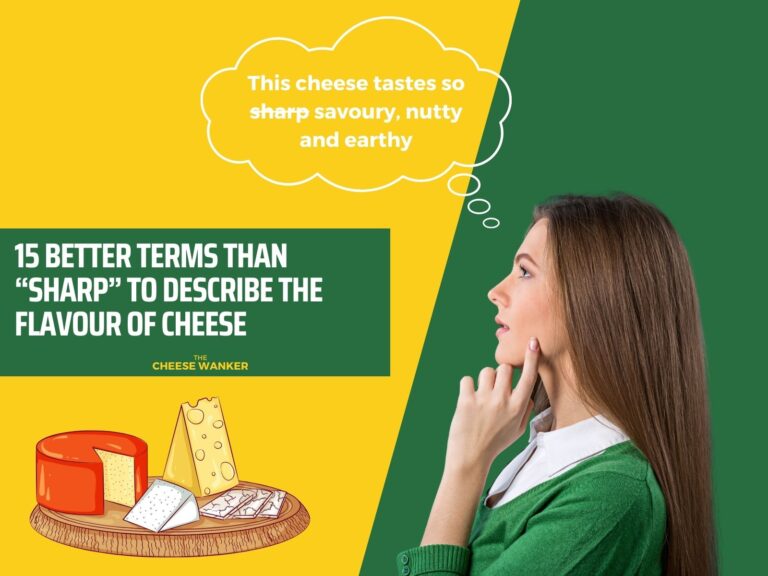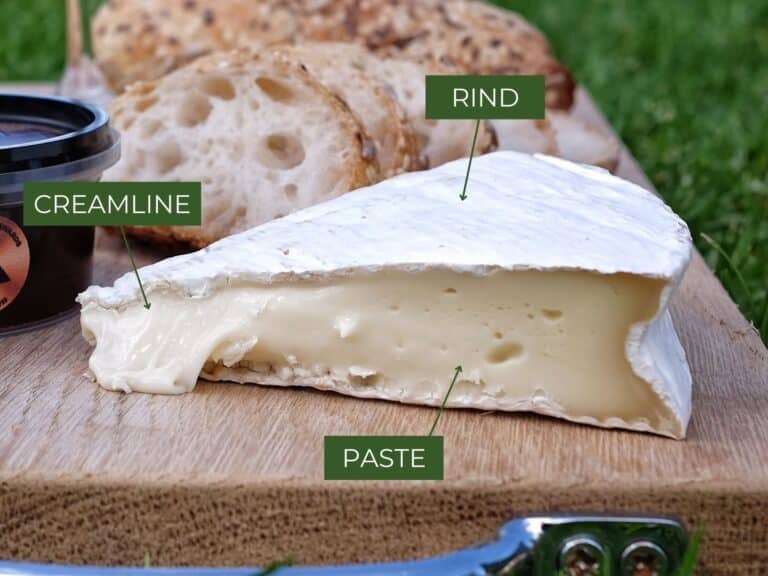Cheese lovers, buckle up! We’re diving deep into the world of cheese lingo, unravelling the mysteries behind those terms that often leave us scratching our heads. Whether you’re a cheese lover or just a casual fan, understanding these terms is like discovering the secret code to the cheese kingdom. So, join us as we unveil 5 of the most frequently misused cheese terms.

READ MORE: The world’s most complete glossary of cheese terminology →
Why proper cheese terminology matters
Picture this: you walk into a cheese shop, the air rich with the aroma of aged Cheddars and earthy Camemberts. The knowledgeable cheesemonger asks what you’re looking for, and you hesitate, stumbling over your words, unsure of how to describe your cheese desires.
That’s where proper cheese terminology becomes your trusty sidekick, guiding you through the flavourful universe of dairy delights.
Precision in communication
Using the right cheese terms is like having a secret language among cheese enthusiasts. If you ask for a “sharp Cheddar”, you’re not adequately describing the cheese you seek.
Proper terms ensure clear communication, helping you get the cheese you crave and enhancing your overall cheese experience.
Appreciating diversity and heritage
Cheese, like people, comes in all shapes, sizes and flavours. Proper terminology celebrates this diversity. When you understand terms like “artisanal” and “farmhouse”, you acknowledge the craftsmanship and traditions behind each cheese.
This knowledge fosters respect for different cheese styles and the artisans that produce them.
Building cheese communities
Cheese lovers are a passionate bunch, and proper terminology strengthens this vibrant community. When enthusiasts, chefs and producers share a common language, it fosters a sense of belonging.
Cheese festivals, tasting events and online forums become spaces where enthusiasts can geek out together, deepening their love for all things cheese.
Supporting local producers
When you know your cheese terms, you become an informed consumer. You can ask questions about a cheese’s production process, origin and flavour profile. This knowledge empowers you to support local and artisanal cheesemakers, encouraging sustainable practices and ensuring the continued existence of unique, high-quality cheeses.
In essence, proper cheese terminology isn’t just about impressing your friends or sounding sophisticated. It’s about delving into the heart of cheese culture, appreciating the craftsmanship behind each wheel, and connecting with a global community of cheese enthusiasts.
Top 5 misused cheese terms
Now that we’ve got the basic out of the way (or is whey?), let’s have a look at some of the most misused cheese terms.
Brie – not all soft cheeses are Brie
In the realm of soft, white mould cheeses, a common misconception prevails: the tendency to label all such cheeses as “Brie”. However, this oversimplification overlooks the intricate world of cheese varieties.
While Brie is indeed a prominent member of this category, it is not a universal term for all similar cheeses. Originating from the Île-de-France region in France, Brie holds a unique status with its Appellation d’Origine Protégée (AOP) designation, indicating specific production methods and regional authenticity.
Indeed, the mislabelling of all soft white mould cheeses as Brie does a disservice to both Brie and other cheeses in this category. This misconception dismisses the diverse array of flavours and textures found within this category.
For instance, Camembert differs subtly in taste and texture, showcasing its own distinct characteristics. By erroneously grouping all these cheeses under the Brie umbrella, we miss the opportunity to explore the individuality of each type, each bearing the imprint of its specific terroir and cultural heritage.
Sharp – there are better ways to describe an aged cheese’s flavour
The term “sharp” is a rather ambiguous and imprecise way to describe the organoleptic properties of cheese. When someone says a cheese is “sharp”, it can mean different things to different people.
Moreover, this ambiguity can lead to many misunderstandings, hindering meaningful discussions about the distinct characteristics of cheeses.
Cheese flavour is influenced by various factors, including ageing, production methods, milk source and the presence of specific microorganisms. When we use a blanket term like “sharp” to describe the taste of cheese, we overlook the intricate nuances that make each cheese unique.
You can read more about this and uncover more accurate alternatives for describing aroma and flavour in our blog post here.
Charcuterie – cooked meat not cheese
Charcuterie is a French portmanteau word that brings together “chaire” (flesh or meat) and “cuite” (cooked). So, combine the two and you get cooked meat right?
Indeed, it relates to a range of cooked meats that can be served cold or warm. And a charcutier is someone who makes and/or sells charcuterie. Notice how there is no connection to cheese?
Over the last decade, charcuterie boards have grown in popularity in the USA and Australia. Unfortunately, there are many businesses selling “charcuterie” boards that don’t even have any meat on them.
Let’s be clear here. A charcuterie board is a board with charcuterie (meat) on it. Of course, meat does not have to be the only component of the board. After all, one of the most common pairings is cheese.
Having said that, there are only two acceptable terms to describe a plate that combines both cheese and charcuterie. Namely, a charcuterie board with cheese, or a cheese board with charcuterie.
Accoutrements – clothing, not accompaniments
Next, let’s unravel a linguistic entanglement: the term “accoutrements”. Despite its French origin suggesting articles of clothing, in the culinary sphere, it has been mistakenly used to describe the delightful edibles adorning a cheese board.
The accurate term for these delectable additions is “accompaniments”. Accoutrements, in its truest sense, pertains to clothing, accessories or trinkets. On the other hand, accompaniments specifically refer to the delicious spread of fruits, nuts, bread, honey and pickles that beautifully complement the cheeses on a board.
While the confusion might be amusing, it’s vital to acknowledge the correct terminology. Accoutrements might enhance your attire, but on a cheese board, it’s the accompaniments that steal the show, adding layers of flavour, texture and aroma to your cheese tasting experience.
So, the next time you’re curating a cheese board, remember to invite the right guests: the cheeses and their accompaniments, leaving the accoutrements in your wardrobe where they belong.
Stinky – disrespecting the cheesemaker’s craft
When it comes to describing the rich, diverse world of cheese, the term “stinky” might spring to mind for some. However, this descriptor, though often used colloquially, does a disservice to the intricate aromas and flavours that cheeses possess.
Cheese, like fine wine, boasts a myriad of complex aromas. From earthy notes in Brie to the nutty undertones of Gruyère, each cheese variety has its unique scent profile.
Reduced to just “stinky”, these nuanced aromas, which are a testament to the cheese’s origin, ingredients and ageing process, are overlooked. The aroma of cheese is a symphony of scents, reflecting the terroir of the region it comes from and the meticulous craftsmanship involved in its creation.
Furthermore, taste and smell are highly subjective experiences. What one person finds overpowering, another might find intriguing and delightful. Educating our senses and expanding our palate can transform what might initially be perceived as “stinky” into a captivating aroma.
By exploring a variety of cheeses and understanding their aromas, we can move beyond simplistic labels and appreciate the intricate tapestry of scents that each cheese offers.
Conclusion
In the vibrant world of cheese, understanding the nuances of terminology is akin to deciphering a secret code. As we wrap up our cheesy expedition through the most commonly misused cheese terms, one thing becomes abundantly clear: cheese is not just a food; it’s a language, a culture and a journey of discovery.
So, whether you’re savouring the tang of a well-aged cheddar, relishing the creaminess of a bloomy-rind Brie, or exploring the bold depths of a blue cheese, remember that behind each flavour, there’s a story—a tale of terroir, technique, and timeless culinary artistry.
Let’s celebrate not just the taste but also the rich tapestry of cheese terminology that adds depth and dimension to our cheese-loving adventures.



